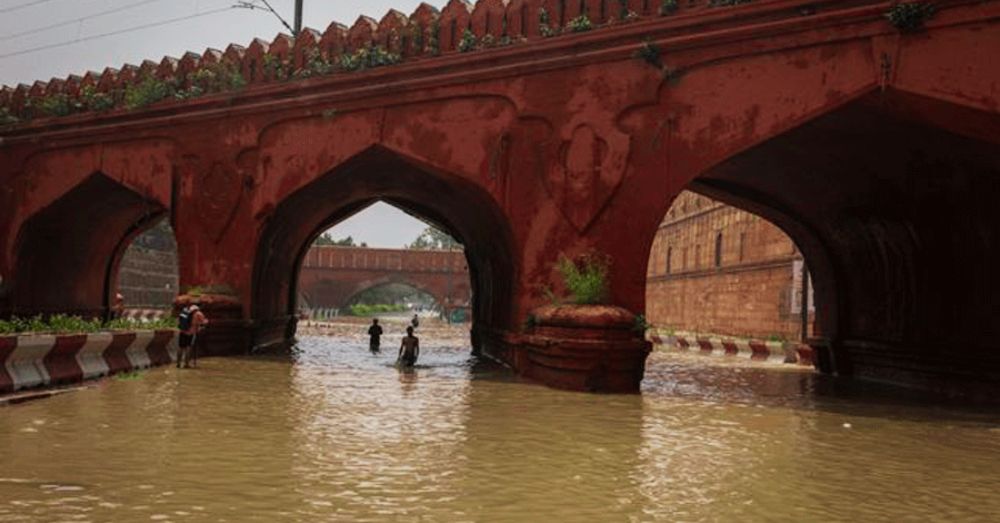Delhi, the capital city of India, is currently grappling with a severe flood caused by the Yamuna River’s overflowing waters. This flood differs from the previous ones because it is not just the impoverished communities along the Yamuna affected; even posh colonies are stranded.
The floodwaters have disrupted the functioning of water treatment plants, leading to water scarcity in many parts of the city. This dire situation is a harsh reminder of the warnings given by Manoj Mishra ji, a former Indian Forest Service (IFS) officer and renowned environmentalist who has long advocated for the preservation of the Yamuna through his Yamuna Jiye Abhiyaan.
Floods are a natural phenomenon, but what we are witnessing in Delhi is a man-made disaster.
The root cause of the problem lies in a misplaced assumption that constructing dams and canals can prevent floods.
In reality, floodplains are meant to serve as the natural passage for water, and altering the natural flow of rivers can have dire consequences.
While floods are common during the monsoon season in various parts of India, such as Assam, Bihar, Uttar Pradesh, and Kerala, this year’s rainfall has wreaked havoc across the country. Homes have been destroyed, lives have been lost, and the fury of the floods shows no signs of abating. Images and videos flooding the internet depict the extent of the deluge that has engulfed Delhi.
The Yamuna River, the fifth longest river in India, has historically provided livelihoods to millions of people and served as a source of spiritual inspiration. However, the river has recently been the subject of concern due to its alarming pollution levels and encroachment on its banks.
Originating from the frozen Champasar Lake in the Bandarpooch Glacier, the Yamuna winds through snow-capped valleys and forests in the Himalayas before flowing into the Indo-Gangetic plains. Spanning 1376 kilometers, it eventually merges with the Ganga at Allahabad. Along its course, the river passes through diverse agroclimatic and agroecological zones, hosting a variety of communities.
The Yamuna supports approximately 57 million people, with 4400 cubic billion meters of water used for irrigation and supplying 70 percent of Delhi’s potable water.
The Obstacles Faced by Yamuna
Hydropower projects, dams, stone mining, dumping of debris and solid waste, receding glaciers, deforestation, climate change, lack of flow, sand mining, water-intensive and chemical farming, industrial pollution, floodplain encroachment, flattening of ravines, and the use of blasting and poison in fishing are all contributing factors to the sorry state of the Yamuna.
The challenges faced by the Yamuna are numerous and interconnected. Despite being fed by over 70 rivers, many of its tributaries have dried up or become polluted, with only a few, like Ken, Sind, Betwa, and Chambal, able to revive the river in its lower segment.
The construction of barrages and dams has disrupted the river’s natural flow, compromising its integrity. Delhi alone has constructed three barrages on the Yamuna within 22 kilometers, exacerbating the problem. Riparian states plan to build more barrages, including the Katapathar Barrage in Uttarakhand, Panipat Barrage in Haryana, and Agra Barrage in Uttar Pradesh. There are even discussions of a barrage at Palla in Delhi. Moreover, the non-functional ITO barrage in Delhi needs to be decommissioned.
Despite implementing various action plans, including the Yamuna Action Plan in 1994 and subsequent phases in 2002 and 2012, more progress has yet to be made in improving the river’s condition.
The Yamuna continues to deteriorate, casting a dark shadow on its future. Moreover, the heavy rainfall across India this year has exposed poor planning by authorities, as cities like Gurugram and Noida witness pools and waterfalls where urban development should have been.
Let the Yamuna Flow
To address this crisis, we must prioritize preserving Yamuna’s natural flow and refrain from further interfering with the construction of barrages and dams. Instead, we should explore sustainable and eco-friendly alternatives for energy generation. Efforts must be made to curb pollution from industries and sewage, enforce stricter regulations on sand mining, promote responsible farming practices, and prevent encroachment on the floodplains.
Additionally, the restoration and rejuvenation of the Yamuna’s tributaries should be prioritized to ensure the revival of a healthy and thriving river ecosystem.
Reversing the damage inflicted upon the Yamuna requires a collective effort from governments, communities, and individuals. We must launch awareness campaigns, engage communities, and strictly enforce environmental regulations to drive the necessary change. Technological innovations and scientific research can also offer valuable insights and solutions for river restoration.
We must not forget the immense significance of the Yamuna in our lives. Our responsibility is to act swiftly and decisively to save this precious resource. The time to act is now, as any further delay risks the permanent loss of the Yamuna and the spirit of Delhi. Let us come together to reclaim the glory of the Yamuna and restore it to its rightful place as a symbol of our heritage and a lifeline for future generations.
